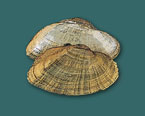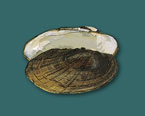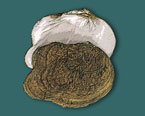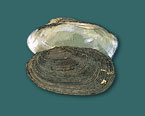
Sometimes it just takes one man’s vision to illuminate the
obvious. Muscatine, Iowa is a long way from Hamburg, Germany. The hard
labor of a farmhand must have seemed a daunting proposition to newly arrived
immigrant J. F. Boepple. Legend has it that Boepple was wading through
the shallows of an Illinois stream when he cut his heel. Reaching down,
he brought up the offending mussel shell and realized it was similar in
size and shape to the sea shells he had used for buttons back in his native
Germany. If it was strong enough to savage his foot it was strong enough
to create a button. A multi million dollar industry was born.
BOEPPLE FULFILLS HIS DREAM
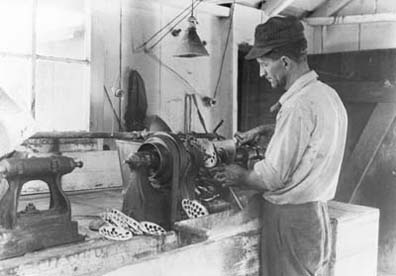 It’s
a good story and it may have happened just like that, but in truth Boepple
came to America looking for freshwater mussels suitable for the button
trade. It’s known that he received samples of American mussels while
still making buttons in Germany. His quest led him to Muscatine, Iowa;
he must have stood on the riverbank amazed. A seemingly endless supply
of shells there for the taking; yellow sandshells, pistolgrips, ebonyshells.
It was an incredible natural resource, the great mussel beds of the Mississippi
River.
It’s
a good story and it may have happened just like that, but in truth Boepple
came to America looking for freshwater mussels suitable for the button
trade. It’s known that he received samples of American mussels while
still making buttons in Germany. His quest led him to Muscatine, Iowa;
he must have stood on the riverbank amazed. A seemingly endless supply
of shells there for the taking; yellow sandshells, pistolgrips, ebonyshells.
It was an incredible natural resource, the great mussel beds of the Mississippi
River.
He noted in his autobiography, “At last I have found what I had been
looking for; yet there still was a problem before me. I was without
capital in a strange land among strange people and unfamiliar with
the language.”From Boepple’s first crude, foot driven lathe the trade
blossomed into one of the largest and most profitable fisheries in
the inland United States. Sixty button factories lined the banks of
the Mississippi near Muscatine Iowa by 1899. Ten years after Boepple’s
inspiration, the industry supported thousands of workers. Its value
was calculated in the millions of dollars. The future looked bright
for communities along the Mississippi.
LIFE OF THE CLAMMER
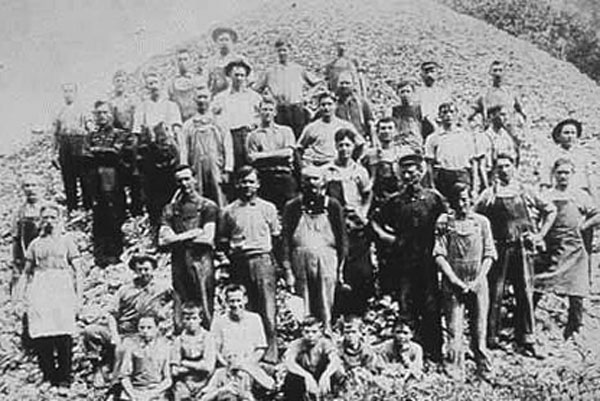
Clammers
To supply this industry, the lifestyle of the clammer immerged.
An itinerant flotilla of shanty boats worked the mussel beds. The clammers,
like river men everywhere, were a colorful lot. They could make good money
if they were on a new bed, up to ten dollars a day. And there was always the
possibility of finding that life changing pearl. Clammers answered to no one
but themselves; unsavory “mussel camps” sprung up overnight. Local residents
complained about the ripe odors as the clammer boiled their catch to open the
shells. But the town folk didn’t complain about the money coming into their
communities. Muscatine had the feeling of a boom town as the industry flourished. All
it took to put a clammer in business was a small boat and crowfoot, an iron
bar with a few dozen hooks attached. As the tool was dragged across the riverbed,
mussels instinctively snapped down upon contact with the hook. It was
devastatingly effective. Downriver from Muscatine, a one and one half mile
section of river gave up ten thousand tons of shells. By 1898 this bed, one
of the most productive on the river, was gone. The clammers simply moved on
to the next bed on the river.
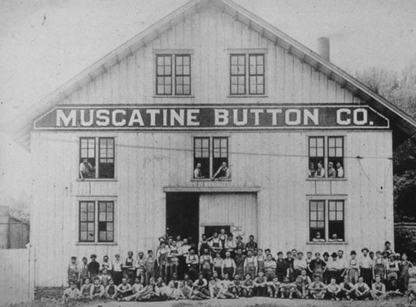
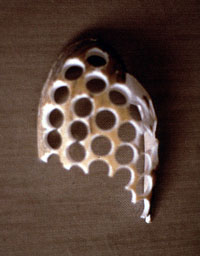
Muscatine Factory and Cut-out Mussel shell
The demand for freshwater mussel shells kept growing. Orders were pouring
in from all parts of the United States, huge shipments of buttons made their
way across the Atlantic to Europe. Automated button manufacturing equipment
accelerated the process. An estimated 11.4 million buttons were produced
from freshwater mussel shells in 1904. Ten years later 21.7 million buttons
went to market. Production peaked just a few years later when 40 million
buttons were produced in 1916. At that time there were twenty thousand people
employed in the button industry. These were good jobs with regular wages,
a real economic boost to local communities. But the boom couldn’t last.
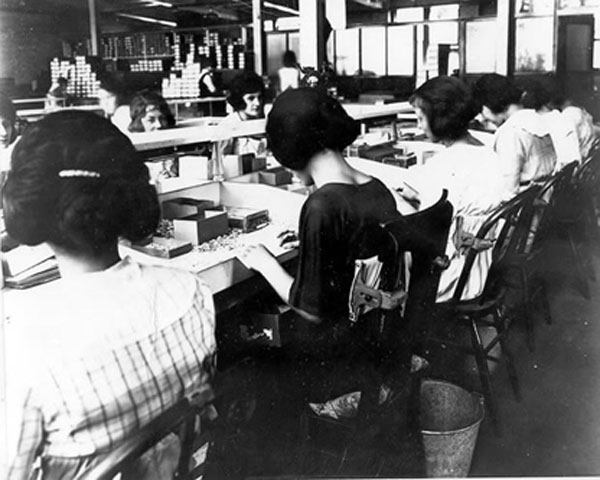
Workers at the Muscatine Button Co.
JUST GROW MORE MUSSELS
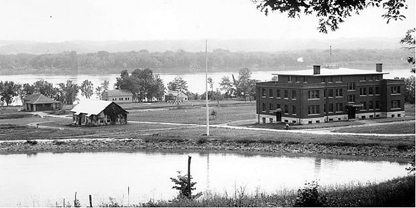
Fairport Biological Station
Intense, unregulated harvest quickly depleted the larger mussel beds.
In 1907 the U.S. Bureau of Fisheries stepped in to try to protect the industry.
Two biologists from the University of Missouri were engaged to prevent the
“commercial extinction” of freshwater mussels. George Lefevre and Winterton
Curtis began the complicated task of creating an artificial propagation program.
Curiously, but perhaps telling for the times, no serious effort was made to
regulate the freewheeling itinerant clammer with their devastating iron crowfeet
dragging up and down the river. The solution was simply to propagate more mussels,
not to regulate the harvest. Lefevre and Curtis published the results of their
research in the Journal of Experimental Zoology in 1910. The project
was a success; they had developed a method to artificially propagate mussels.
The Bureau of Fisheries, under the direction of Robert Coker, began commercial
scale propagation of freshwater mussels in 1912 at the Fairport Biological
Station. They concentrated on the Upper Mississippi. The object was to bring
the juvenile mussels up to “planting size”. Like an agricultural crop, mussels
would simply be planted in the river for later harvest. Over one billion juvenile
mussel “seeds” were produced. But as scientists at the Bureau of Fisheries
soon learned, the problem was not with the seeds, it was with the ‘farm’ itself.
New agricultural practices added silt to the rivers, sewage from the nation’s
new cities polluted the water. The rivers were becoming unsuited for juvenile
mussels. The U.S. Army Corps of Engineers planned dams on the Upper Mississippi,
effectively stopping host fish from facilitating new mussel beds. By 1930,
the Bureau of Fisheries ceased its mussel propagation program, going as far
as recommending that the states repeal the limited harvest regulations they
had enacted. The Bureau gloomily reported, “It appears that the mussel fishery
on the Mississippi River is doomed to economic exhaustion” and urged that
the industry harvest the remaining mussels before they were killed by silt
or pollution.
J.F. Boepple died a poor man. He’d watched as the industry created by his vision blossomed into a powerful economic engine. He then watched it falter as the resource that fueled this engine vanished. At the end of his life, Boepple was working with the U.S. Bureau of Fisheries, trying to protect and conserve the natural resource that had been so pivotal for him; the freshwater mussel. Sometimes, one man’s vision can have unforeseen consequences.


